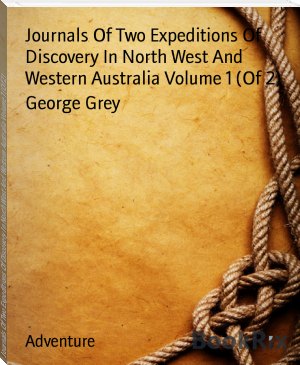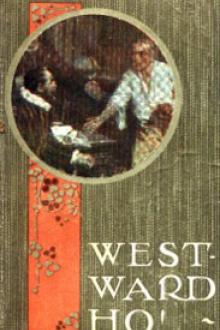Journals Of Two Expeditions Of Discovery In North West And Western Australia Volume 1 (Of 2) by George Grey (best ereader for pdf .txt) 📖

- Author: George Grey
Book online «Journals Of Two Expeditions Of Discovery In North West And Western Australia Volume 1 (Of 2) by George Grey (best ereader for pdf .txt) 📖». Author George Grey
Height From Ground To Top Of Head, 2 Feet 4 Inches.
Temperature 98 Degrees.
Third Specimen. The Largest Bird Of The Kind I Have Hitherto Seen.
Length From Tip Of Wing To Tip Of Wing, 10 Feet 8 Inches.
Length From Tip Of Beak To Tip Of Tail, 4 Feet 6 Inches.
Breadth Across The Body, 8 Inches.
Length Of Bill, 6.7 Inches.
Length Of Foot, 7.5 Inches.
Fourth Specimen. The Same Size As The Second.
Length Of Beak, 6.3 Inches.
Length Of Foot, 6.9 Inches.
The Beak Of Each Of These Birds During Lifetime Was Of A Beautiful Light
Rose Colour; Their Voice Was Something Like That Of A Goose, But Rather
Louder, Deeper, And Hoarser. If During Life The Beak Was Pressed With The
Finger It Became Quite White, And It Was Not Until The Pressure Had For
Some Time Been Removed That The Colour Returned. The Specimens I Have
Described Above (All Males) Were Quite White Underneath; The White Above
Being Speckled With Black Spots And Streaks, Sometimes Changing To A
Brownish Hue; The Wings Were Black. We Obtained Also A Female Bird With
The Following Measurements, Which Has Been Described As A Distinct
Species:
Length From Tip To Tip Of Wing, 7 Feet 2 Inches.
Length From Tip Of Tail To Tip Of Beak, 3 Feet 5.5 Inches.
Length From Root To Tip Of Tail, 9 Inches.
Length Of Beak, 4.5 Inches.
Length Of Foot, 5 Inches.
Legs Pale Flesh Colour; Beak, Black, With A Brown-Coloured Streak On Each
Side Of The Lower Mandible; The Whole Body Of A Dirty Black Colour,
Acquiring A Lighter Tinge Underneath.
October 30.
I Shot Two Male Specimens Of This Last Bird: The Only Distinction Between
Them And The Female Was That They Were Rather Smaller, And Had A White
Streak Instead Of A Light Brown One On Each Side Of The Lower Mandible.
First Specimen--Male. Weight, 5 1/2 Pounds.
Length From Tip Of Wing To Tip Of Wing 6 Feet 6 Inches.
Length From Tip Of Beak To Tip Of Tail, 2 Feet 6 Inches.
Length From Root To Tip Of Tail, 11 Inches.
Length From Root To Tip Of Beak, 4 Inches.
Length From Root To Tip Of Foot, 5 Inches.
Length From Root To Tip Of Wing, 2 Feet 10 Inches.
Volume 1 Chapter 3 (From The Cape Of Good Hope To Hanover Bay) Pg 29
Second Specimen--Male. Weight 7 Pounds.
Length From Tip To Tip Of Wing, 6 Feet 9 Inches.
Length From Tip Of Beak To Tip Of Tail, 2 Feet 10 Inches.
Length Of Tail, 10.6 Inches.
Length Of Beak, 4.7 Inches.
Length Of Foot, 5 Inches.
Length Of Wing, 3 Feet.
All The Three Specimens Of This Species Had A Distinct Although Minute
Claw, Representing A Thumb, Upon One Leg, Thus Apparently Forming A Link
Between The Genus Procellaria And The Genus Diomedea.
Pachyptila Vittata.
Ash-Grey Above; White In The Under Parts; Quills, Tail-Feathers At The
Tip, And Band On The Wings When Expanded, Brownish-Black.
Length From Tip To Tip Of Wing, 2 Feet.
Length From Tip Of Beak To Tip Of Tail, 10 Inches.
Length From Root To Tip Of Tail, 4.3 Inches.
Length Of Beak, 1 Inch.
Length Of Foot, 1.5 Inches.
Length Of Wing, 10.5 Inches.
This Bird Is Of The Same Species As The One I Procured On The 16th Of
October. I Shot It About Nine A.M. They Are Very Numerous In These
Latitudes; Their Flight Resembles Much That Of A Snipe. The Name By Which
They Are Known To The Sailors Is The Whale-Bird; They Appear To Take
Their Food Upon The Wing, For I Have Never Yet Seen Them Sit Upon The
Waters Even For A Single Second, Although I Have Observed Them
Frequently, And At All Hours; But Night And Day They Hurry On With The
Same Restless, Rapid Flight, Sometimes Going In Large Flocks; And I Have
Never Upon Shore Seen So Many Birds Assembled Upon A Few Square Miles As
I Have Sometimes Here Observed In The Open Ocean. I Never Heard Them
Utter Any Cry Or Sound.
I Saw But Few Cape Pigeons (Procellaria Capensis) After Passing The 40th
Degree Of Longitude, And Neither Cape Pigeons Nor Albatrosses After
Passing The 95th Degree Of Longitude, And 32nd Parallel Of Latitude. I
Have Never Seen A Petrel Or Bird Of The Family Longipennes Discharge Its
Oily Fluid At Anyone Who Worried Or Attacked It; But Have Almost
Invariably Seen It Involuntarily Eject It,When Hurt Or Frightened.
The Albatross.
November 9.
I Caught Four Albatrosses With A Fishing-Line; One Of Them Was A Female,
The First I Had Seen. I Observed No Marked Difference Between Her And
Males Of The Same Species, For I Have Found Them Vary Much In The Dark
Shades Upon Their Feathers.
Volume 1 Chapter 3 (From The Cape Of Good Hope To Hanover Bay) Pg 30
I Have Yet Found No Bird Of This Family Whose Foot Was Not Longer Than
Its Beak.
Diomedea Exulans--Female.
Length From Tip Of Wing To Tip Of Wing,10 Feet 10 Inches.
Length From Tip Of Wing, 4 Feet 10 Inches.
From Tip Of Beak To Tip Of Tail, 4 Feet 9 Inches.
Length Of Beak, 7.2 Inches.
Length Of Tail, 9 Inches.
Length Of Foot, 7.5 Inches.
The Black And Brown Marks On This Bird Were Darker Than The Corresponding
Ones On The Males.
I Am Inclined To Think That The Chief Characteristic That Distinguishes
The Females From The Males In The Family Longipennes Is Their Greater
Size: My Opinion Is Grounded Upon The Following Tables, Drawn Up From
Careful Measurements, Made By Myself.
(@@@Table Of Family Longipennes)
In Each Of These Three Instances The Female Is Larger Than The Males;
They Are The Only Ones I Am Able To Adduce Which Bear Upon This Point.
November 11. South Latitude 30 Degrees 47 Minutes; East Longitude 100
Degrees 21 Minutes 15 Seconds.
Being A Calm, I Gave The Men Leave To Bathe This Afternoon, And Was One
Of The First Overboard Myself. Within An Hour And A Half After We Had
Done Bathing, A Cry Of A Shark Was Raised, And In Truth There Was The
Monster (The First We Had Seen). I Mention This Fact As Tending To
Support What I Have Often Heard Stated, Namely, That A Shark's Sense Of
Smell Is So Keen That, If Men Ever Bathe In Seas Where They Are Found, A
Shark Is Almost Sure To Appear Directly Afterwards. This Really Occurred
In The Present Instance.
We Repeatedly Caught Many Little Animals Which I Believe Are The Velella
Of Lamarck. They Consist Of A Flat Oval Cartilage, On Which They Float;
There Is A Mouth In The Inferior Surface Of This Surrounded With Many
Tentacula; On Its Superior Surface Is A Crest Which Remains Above Water,
And The Wind Blowing Against It Turns The Animal Round; They Thus Swim
With A Rotatory Motion; The Crest Is Placed Obliquely To The Length Of
The Oval Cartilage, And This Position Of It Perhaps Assists In Producing
The Motion; The Crest Is Perfectly Transparent, But Marked With Little
Striae; The Oval Cartilage Is Marked With Concentric Striae, Which
Indicate The Lines Of Its Growth; In Some This Cartilage Is Transparent,
In Others Quite Blue.
November 12. South Latitude 30 Degrees 11; East Longitude 100 Degrees 31
Minutes 30 Seconds.
Volume 1 Chapter 3 (From The Cape Of Good Hope To Hanover Bay) Pg 31
We Caught Several Beautiful Animals This Day, Of The Medusae Kind
(Diphya). (See Illustration 3 Diphya, Sp.)
Figure 1 Represents A Section Through One Of Them, The Size Of Life: The
Bag (1) Is Of A Delicate Bright Amber Colour. The Long Tentacula Issuing
Out Are Upwards Of A Foot In Length And Of A Bright Flesh Colour.
Figure 2 Is A Section Across The Animal.
Figure 3 Represents The Mouth Of The Large Opening At C, D, As If One Was
Looking Down Into It.
Figure 4 Upper Part; Figure 5 Lower; And Figure 6 The Perfect Animal.
Between C D Apparently Lay The Entrance To Its Mouth; In The Little Bag
Marked (3) Its Long Tentacula Were Concealed, And Below These Lay A
Little Gut Marked (4) Which Communicated With The Point (L) By A Small
Canal: (1) Was Its Swimming Apparatus, And By Alternate Contractions And
Expansions Of This, It Took In And Expelled Water, And Thus Acquired A
Rapid Motion, The Pointed End (L) Moving Forwards.
Its Length Was 1.7 Inches.
Breadth, 0.7 Inches.
Thickness, 0.35 Inches.
Temperature The Same As The Water, 65 Degrees Fahrenheit.
The Sketch Illustration 4 Diphya, Sp. Gives A Faint Idea Of The Most
Beautiful Animal Of This Kind Which I Have Ever Seen. It Was So Delicate
That, With The Slightest Touch, Portions Of It Came Off, Hence The
Specimen We Obtained Is I Fear Useless. The Body Consisted Only Of A
Central Canal, To Which Were Attached A Number Of Gelatinous Bags, With
Large Lateral Openings, So Large That Other Zoophytes Were Caught In
Them, And Apparently Annoyed The Animal; Who Continued Throwing Water Out
Until It Expelled Them. The Whole Was Surmounted By A Number Of The Most
Beautiful Rose-Coloured Tentacula: I Counted Eleven On It, And Found Four
More That Were Torn Off, But There May Have Been More. Its Top, When
Looked Into Closely, Resembled Some Of The Sea Anemones; And Inside Of
The Large Bright Orange-Coloured Tentacula Were Placed Circular Rows Of
Smaller Ones. Its Body Was Quite Transparent, With The Exception Of The
Central Canal, Which Was Of A Milk-White Colour, And Terminated In A
Small Sac Of The Same Hue.
It Moved In A Direction Opposite To The Tentacula, By Taking In Water At
The Lateral Openings Of The Bags, In The Position In Which It Is
Represented; Then Bending These Towards The Tentacula, And Expelling It
With Great Violence.
Temperature The Same As The Water, 65 Degrees Fahrenheit.
Length Of Body (To Tentacula From Root Of Tail-Like Canal) 1.8 Inches.
 Nowadays a big variety of genres are exist. In our electronic library you can choose any book that suits your mood, request and purpose. This website is full of free ebooks. Reading online is very popular and become mainstream. This website can provoke you to be smarter than anyone. You can read between work breaks, in public transport, in cafes over a cup of coffee and cheesecake.
Nowadays a big variety of genres are exist. In our electronic library you can choose any book that suits your mood, request and purpose. This website is full of free ebooks. Reading online is very popular and become mainstream. This website can provoke you to be smarter than anyone. You can read between work breaks, in public transport, in cafes over a cup of coffee and cheesecake.




Comments (0)